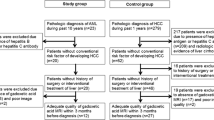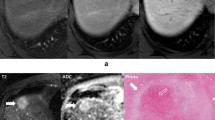Abstract
Objective
The purpose of this study was to evaluate MRI features for the differentiation of hepatic angiomyolipoma (HAML) from fat-containing hepatocellular carcinoma.
Methods
We retrospectively reviewed the MRI findings of 20 patients with 22 hepatic angiomyolipomas and 25 patients with fat-containing hepatocellular carcinomas before surgery. The MRI features and apparent diffusion coefficient (ADC) for the two types of tumors were compared and analyzed.
Results
Fat was not detected in nine (40.9%) of the angiomyolipomas. An enhancement pattern of the washout area was seen in eight (36.4%) of the angiomyolipomas and 21 of the hepatocellular carcinomas (84%) (p = 0.001). The sensitivity, specificity, and accuracy of the enhancement pattern for HAML were 63.6% (14/22), 84% (21/25), and 74.5% (35/47), respectively. An early draining vein was seen in 16 (72.7%) angiomyolipomas and two hepatocellular carcinomas (8%) (p < 0.001). The sensitivity, specificity, and accuracy of an early draining vein for detecting HAML was 72.7% (16/22), 92% (23/25), and 83.0% (39/47), respectively. Tumor vessels were noted in 18 (81.8%) angiomyolipomas and six hepatocellular carcinomas (24%) (p < 0.001). The sensitivity, specificity, and accuracy of tumor vessels for HAML were 81.8% (18/22), 76% (19/25), and 78.7% (37/47), respectively. Pseudocapsules were absent in 21 (95.5%) angiomyolipomas as compared with 3 (12%) hepatocellular carcinomas (p < 0.001). The sensitivity, specificity, and accuracy of pseudocapsules for HAML were 95.5% (21/22), 88% (22/25), and 91.5% (43/47), respectively. The ADC of the angiomyolipomas (1.92 ± 0.29 × 10−3 mm2/s) was significantly higher than that for hepatocellular carcinomas (1.33 ± 0.25 × 10−3 mm2/s) (p < 0.001).
Conclusion
The presence of an early draining vein and tumor vessels, the absence of pseudocapsules and a higher ADC in the hypervascular hepatic tumor on the MRI were helpful for the differentiation of hepatic angiomyolipoma from fat-containing hepatocellular carcinoma.






Similar content being viewed by others
References
Ishak KG (1976) Mesenchymal tumors of the liver. In: Okuda K, Peters RL (eds) Hepatocellular carcinoma. New York: Wiley, pp 247–307
Prasad SR, Wang H, Rosas H, et al. (2005) Fat-containing lesions of the liver: radiologic–pathologic correlation. Radiographics 25:321–331
Basaran C, Karcaaltincaba M, Akata D, et al. (2005) Fat-containing lesions of the liver: cross-sectional imaging findings with emphasis on MRI. AJR Am J Roentgenol 184:1103–1110
Yan F, Zeng M, Zhou K, et al. (2002) Hepatic angiomyolipoma: various appearances on two-phase contrast scanning of spiral CT. Eur J Radiol 41:12–18
Jeon TY, Kim SH, Lim HK, Lee WJ (2010) Assessment of triple-phase CT findings for the differentiation of fat-deficient hepatic angiomyolipoma from hepatocellular carcinoma in non-cirrhotic liver. Eur J Radiol 73:601–606
Chung AY, Ng SB, Thng CH, Chow PK, Ooi LP (2002) Hepatic angiomyolipoma mimicking hepatocellular carcinoma. Asian J Surg. 25:251–254
Cai PQ, Wu YP, Xie CM, et al. (2013) Hepatic angiomyolipoma: CT and MRI imaging findings with clinical–pathologic comparison. Abdom Imaging 38:482–489
Ahmadi T, Itai Y, Takahashi M, et al. (1998) Angiomyolipoma of the liver: significance of CT and MR dynamic study. Abdom Imaging 23:520–526
Ji JS, Lu CY, Wang ZF, et al. (2013) Epithelioid angiomyolipoma of the liver: CT and MRI features. Abdom Imaging 38:309–314
Martin J, Puig J, Falco J, et al. (1998) Hyperechoic liver nodules: characterization with proton fat–water chemical shift MR imaging. Radiology 207:325–330
Pupulim LF, Hakimé A, Barrau V, et al. (2009) Fatty hepatocellular carcinoma: radiofrequency ablation: imaging findings. Radiology 250:940–948
Bieze M, van den Esschert JW, Nio CY, et al. (2012) Diagnostic accuracy of MRI in differentiating hepatocellular adenoma from focal nodular hyperplasia: prospective study of the additional value of gadoxetate disodium. AJR 199:26–34
Itai Y, Ohtomo K, Kokubo T, et al. (1986) CT of hepatic masses: significance of prolonged and delayed enhancement. AJR 146:729–733
Kim SH, Lim HK, Lee WJ, Choi D, Park CK (2009) Scirrhous hepatocellular carcinoma: comparison with usual hepatocellular carcinoma based on CT-pathologic features and long-term results after curative resection. Eur J Radiol 69:123–130
Hooper LD, Mergo PJ, Ros PR (1994) Multiple hepatorenal angiomyolipmas: diagnosis with fat suppression, gadolinium-enhanced MRI. Abdom Imaging 19:549–551
Christopher DM, Fletcher K, Krishnan U, Fredrik E (2002) Pathology and genetics of tumors of soft tissue and bone, vol 222. IARC Press, Lyon
Chang Z, Zhang JM, Ying JQ, GE YP (2011) Characteristics and treatment strategy of hepatic angiomyolipoma: a series of 94 patients collected from four institutions. J Gastrointest Liver Dis 20:65–69
Nonomura A, Mizukami T, Kadoya M (1994) Angiomyolipoma of the liver: a collective review. J Gastroenterol 29:95–105
Tsui WM, Colombari R, Portmann BC, et al. (1999) Hepatic angiomyolipma: a clinicopathologic study of 30 cases and delineation of unusual morphologic variants. Am J Surg Pathol 23:34–48
Kutami R, Nakashima Y, Nakashima O, Shiota K, Kojiro M (2000) Pathomorphologic study on the mechanism of fatty change in small hepatocellular carcinoma of humans. J Hepatol 33:282–289
Yoshikawa J, Matsui O, Takashima T, et al. (1988) Fatty metamorphosis in hepatocellular carcinoma: radiologic features in 10 cases. AJR 151:717–720
Ayyappan AP, Jhaveri KS (2010) CT and MRI of hepatocellular carcinoma: an update. Expert Rev Anticancer Ther 10:507–519
Kim SH, Lim HK, Lee WJ, Choi D, Park CK (2009) Scirrhous hepatocellular carcinoma: comparison with usual hepatocellular carcinoma based on CT-pathologic features and long-term results after curative resection. Eur J Radiol 69:123–130
Winter TC 3rd, Takayasu K, Muramatsu Y, et al. (1994) Early advanced hepatocellular carcinoma: evaluation of CT and MR appearance with pathologic correlation. Radiology 192:379–387
Anysz-Grodzicka A, Pacho R, Grodzicki M, et al. (2013) Angiomyolipoma of the liver: analysis of typical features and pitfalls based on own experience and literature. Clin Imaging 37:320–326
Hussain SM, Zondervan PE, Izermans JN, et al. (2002) Benign versus malignant hepatic nodules: MR imaging findings with pathologic correlation. Radiographics 22:1023–1036
Balci NC, Befeler AS, Bieneman BK, et al. (2009) Fat containing HCC: findings on CT and MRI including serial contrast-enhanced imaging. Acad Radiol 16:963–968
Taouli B, Koh DM (2010) Diffusion-weighted MR imaging of the liver. Radiology 254:47–66
Yoshikawa T, Kawamitsu H, Mitchell DG, et al. (2006) ADC measurement of abdominal organs and lesions using parallel imaging technique. AJR Am J Roentgenol 187:1521–1530
Taouli B, Thakur R, Mannelli L, et al. (2009) Renal lesions: characterization with diffusion-weighted imaging versus contrast-enhanced MR imaging. Radiology 251:398–407
Conflict of interest
None.
Author information
Authors and Affiliations
Corresponding author
Additional information
Sheng-yu Wang, Xin-ping Kuai and Xiao-xi Meng contributed equally to this work.
Rights and permissions
About this article
Cite this article
Wang, Sy., Kuai, Xp., Meng, Xx. et al. Comparison of MRI features for the differentiation of hepatic angiomyolipoma from fat-containing hepatocellular carcinoma. Abdom Imaging 39, 323–333 (2014). https://doi.org/10.1007/s00261-013-0070-0
Published:
Issue Date:
DOI: https://doi.org/10.1007/s00261-013-0070-0




